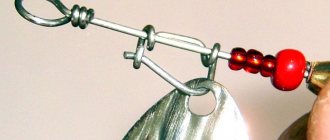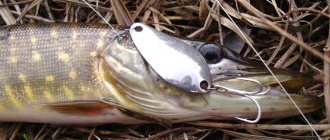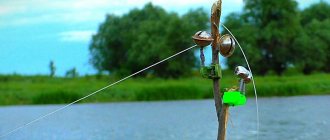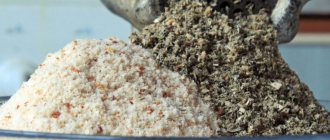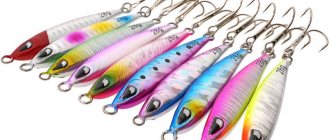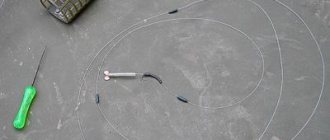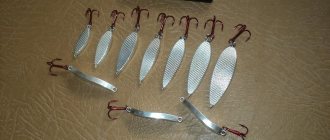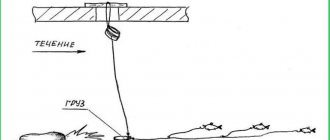Distinctive features of baits
Many fishermen are skeptical about non-hooking hooks, citing the fact that they provoke a large number of empty hooks and disappearances when landing fish.
However, only thanks to them, it is possible to catch such coveted prey as pike in hard-to-reach places in reservoirs:
- in snag;
- in thickets of reservoirs;
- among sunken trees;
- in shallow water in the grass;
- on a rocky bottom;
- in the pits.
A distinctive feature of the bait is that the hook tips are hidden during reeling, which helps to avoid snags, and during the bite they are released and dug into the fish’s mouth.
There are two types of such baits:
- The stings of the hooks are hidden under springy tendrils made of thick fishing line, thin wire, and plastic petals.
- The tip of a single hook is hidden in the body of a twister or vibrotail.
The bait catches fish almost the entire time it is in the water. She catches on any wiring, namely:
- on a stepped one;
- on varied;
- on a wavy one;
- if you fell to the bottom.
No matter how you conduct it, it remains attractive to pike. In any case, the toothy queen will be interested in the unhooked one and want to taste it.
The best non-hooks: top 10
Almost any bait of this type will catch pike in thickets and snags, since even if the bait gets there, it stays there. However, there is a rating of the most catchy lures of this type, which are popular among anglers all over the world. It looks something like this:
- The manufacturer Blue Fox in its line of spinners for pike fishing has an excellent option for guiding through thickets, this is Lucius Weedless. The weight can be 27 g and 36 g, and they will vary slightly in size. Used for catching large species of pike.
- The Russian Spinner company also does not lag behind foreign manufacturers; its Atom-n has three different weights, which allows it to work at different depths.
- XPS Stomper Weedless is something new, but has already gained enormous popularity among fishermen. The bait is distinguished by its acoustic characteristics, which make it more catchable.
- Kuusamo Viiksi is considered a classic among unhooked fish; its catchability has been tested over the years and by several generations of fishermen. Among the negative features is the possibility of fishing only in shallow water areas.
- Gaton Plain differs from other non-hooking ones by the possibility of additional silicone refilling. It will work best on fast wiring.
- The Johnson Silver Minnow is an excellent option for fishing shallow water with algae.
- The Croatian egg, namely Kira Fishing, is an excellent option for catching pike in the frogs. Durable color and a sharp hook will be the key to successfully catching a toothy predator.
- The small Marsh 012 Mystic is a good option for catching grass and snags. This will result in a medium-sized fish on the hook.
- Live Forage is suitable for anglers with experience; the spinner has practically no game of its own, so the successful outcome of the case will depend on your experience.
- Beginners who are new to lure fishing simply love the Acara Aver. It works best in acid colors and does not require much effort when wiring.
These are not all baits that have non-snagging hooks for pike. There are a lot of models and varieties, almost every company produces its own.
The best non-hooking hooks for pike
Mepps Cyclops/MEPPS CYCLOPS
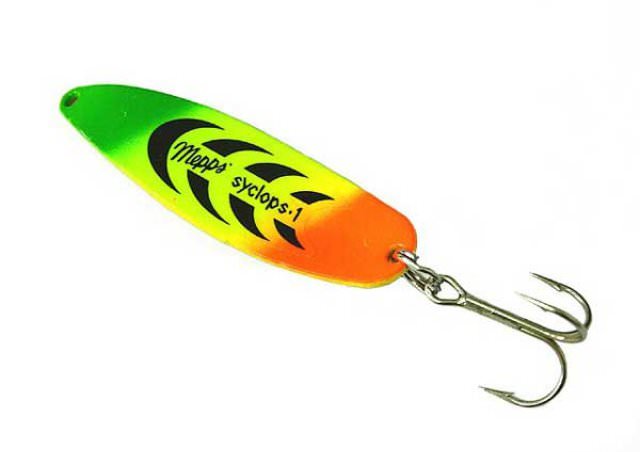
It is good to use this spoon for fishing from the shore; it flies well due to its weight. Weight -28 grams, catch pike with number 3. Thanks to the interesting vibrations, the pike readily bites it and does not go into a tailspin during an accelerated reeling.
Dam EFFZETT
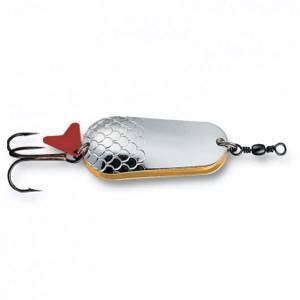
Attention should be focused on a wide spoon, and not on a narrow one. The flight is not bad, but it is most convenient to fish with it on a boat, fishing the channels between the grassy islands and catching pike along the edge of the seaweed.
Kuusamo RASANEN / KUUSAMO RASANEN
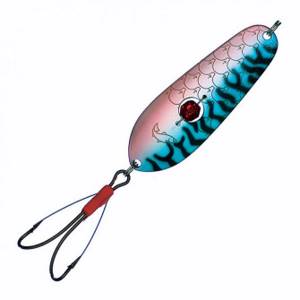
The spoon is designed for trolling salmon in the northern seas. But as it turned out, pike bite on it perfectly, especially in grass thickets, at the largest size. It is large, flies well, and does not float while casting. This lure is convenient for catching small pike.
Akme Little Cleo/AKME LITTLE CLEO
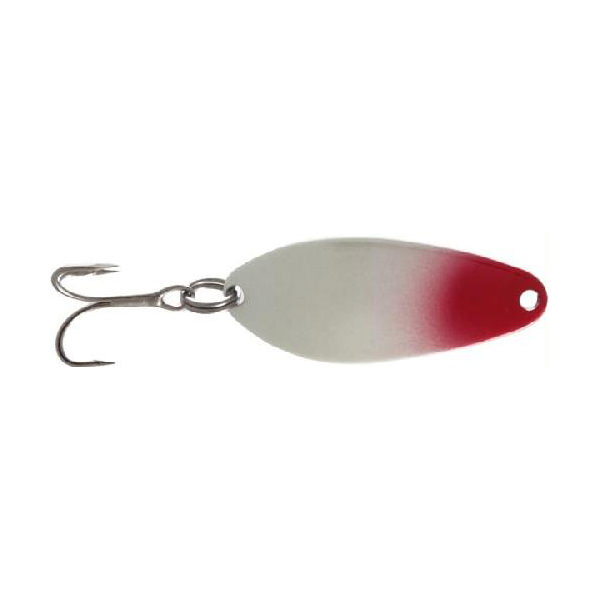
American spinner, which is good for catching predators weighing 6-8 kg. It is advisable to change the tees to larger and stronger ones, because the original ones are rather weak.
ABU GARSIA TOBI
Excellent for catching small and medium fish. Fishing with this bait is a pleasure. I cast it, there was a bite, I took it out, unhooked it, and then everything went in a circle. But large predators do not hunt it, only young animals.
Blue Fox Esox/ BLUE FOX ESOX
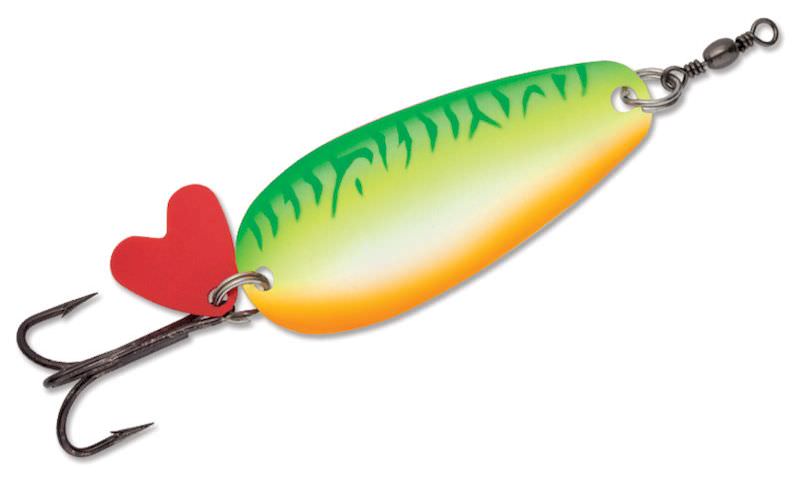
A successful development by a European company, which is a good competitor to the American spinner. Only large specimens are caught. It flies well, has a stepped line, and is convenient for fishing from a boat and for shore spinning.
Making non-snagging bait for shallow water for pike and perch
It’s not just the fishing conditions that vary from place to place. Information borrowed from various sources, including Western ones, is also unevenly distributed across the territory inhabited by Russian-speaking fishermen.
It is interesting to observe how some baits experience a double and sometimes triple “birth”. Nowadays, Russian fishing periodicals pay a lot of attention to oscillating spoons designed for fishing in shallow waters in thickets of aquatic plants. I have interesting memories associated with this bait. In……………… the first non-state fishing store opened in Minsk. It is difficult to convey the feeling of a provincial fisherman finding himself from the grayness of BOOR stores almost into a fairy tale from 1001 nights. It’s not that the entire store assortment is unknown to us, searching fishermen, but it’s one thing to see a photo in a bright catalog, and quite another to be able to touch all this beauty with your own hands. Now it is difficult to surprise anyone with new products, but in those years the newly opened store became a fishing Mecca and Medina at the same time, and people came there not even to buy, but to feel the heady aroma of “Western” fishing. It must be said that the owners of the now defunct (it’s a pity) store really approached the organization of the process and Belarusian fishermen were offered not only the opportunity to purchase gear, but also the opportunity to improve their educational level.
Video cassettes with clips demonstrating various baits, their methods of use and capabilities. Not everything that was on the tapes became a revelation, but many things were perceived anew - in a different context. Among the numerous “new products” on video cassettes, a simple “shaker” was presented, equipped with a “non-weak size” single-handed rod, and the English “fishing lord” Barry Rickards used it to force the “green crocodiles” of one of the Scottish lakes to jump in a frenzy through the thickets of water lilies. The spectacle is not only of rare beauty, but also very convincing. No sooner said than done. And after a very short period of time, I was already distributing the first samples to my comrades. They were converted from ordinary spoons, but had the same capabilities as the baits in the video that came to us from Foggy Albion. The demand was simply frantic, the results were impressive, and this state of affairs soon thoroughly undermined my stocks of blanks for oscillating lures. I would like to make a reservation that even in those years there was no talk about money when transferring bait to any of our friends or acquaintances. These were just gifts, especially since none of them ever talked about paying for fuel for the fishing trip. In a word, it was a different time and the unwritten laws were also different from what can be seen now. The situation was complicated by the fact that I was known as a person working at a bait manufacturing company (the fact that we only produced spinners, jigs and winter verticals could not serve as an excuse).
What to do? The supply of blanks from personal waste was rapidly melting, but I couldn’t refuse the people close to me! The decision came unexpectedly. The fact is that our neighbors in rented office space mastered the production of disposable tableware and supplied us with it for a great living, as is common among good neighbors. And the sets of these dishes available in sufficient supply became the source material for future baits. Even now, in an era of satiety and diversity of assortments in fish stores, it is not always possible to buy something similar, so I will share with you the method that I was born many years ago. The pictures consistently depict a simple manufacturing technology. The first operation will be to remove the handle from the disposable spoon and prepare the top cover of the bait. We prepare the top cover as follows. The ladle of the spoon must be pressed against a piece of sheet metal (copper, brass, ideally tinned tin from a tin can) and traced with a scriber. Next, repeat the contour, but deviating from the main marking line 2-3 mm closer to the center. We get the outline of the top cover blank. Then we will add three mounting tabs. It is these petals that will attach the lid to the body of the future spinner.
The workpiece is highlighted in green after drawing the secondary contour and fastening petals (3 pieces) have been added, the width of which is 4 mm and the length is 8 mm
Next, let's start making the body. To do this, use a red-hot wire to melt three grooves for the mounting tabs in the places where they will be installed. Particular attention must be paid to the heating temperature of the wire. If the temperature is too high, the spoon scoop may melt excessively; if it is underheated, the wire will “freeze” into the plastic. The optimal temperature is selected during the work. Wire should not be taken with a thickness of more than 0.8 mm and it is good if it has springing properties. You can use a small piece of metal to melt the grooves, the size exactly corresponding to the fastening tab. The accuracy of marking for future grooves is very important. Then we cover the bottom of the ladle with a layer of waterproof “Moment” glue (any other similar one can be used) and, without waiting for it to harden, we place the required amount of lead weights of pellets so that they are slightly submerged in the layer of glue. After about an hour (for different glues, the time can vary greatly - keep this in mind), the pellets are filled with a layer of another glue, but this time on top. This ensures that the ballast of the bait is attached.
Here it would be necessary to say a few words about what will change depending on which part of the spoon ladle we glue the ballast into and how we arrange it. The closer to the bow the pellets are placed, the more active the bait will be. Ballast can also be glued along the entire longitudinal axis, distributing the load evenly. We will leave the settings of this plan at the discretion of the direct user - after all, no one bothers you to make several samples and, depending on which one you like, repeat the bait in the future. Subsequent operations are carried out with the top cover. On the lid it is necessary to attach a hook, a wire loop for tying the fishing line and wire non-hooking elements, which will protect the bait hook from unnecessary contacts. Holes are first pierced with an awl under the hook ring, wire loop and antennae.
Three holes are either drilled or pierced with an awl in the workpiece. Hole 1 for the hook ring. Holes 2 and 3 for a loop for tying fishing line
Then we bend a U-shaped piece from the wire for the “whiskers” and place it on the inside of the top cover. From the outside we will make a loop for the fishing line (it is better to make a loop from millimeter copper wire). Bend the ends of the loop from the inside parallel to the plane of the top cover. Holes 2 and 3 must have a diameter that allows the passage of both the loop wire and the mustache wire. When placing both blanks in the holes, you need to ensure that the “whiskers” are located closer to the hook hole, while the loop must be located closer to the nose of the top cover.
The figure shows a cutaway view of one of the installation holes for the wire loop.
After this, solder the workpieces from the inside (when preparing the cover, the installation holes should be tinned on both sides, and then during soldering the solder will flow outward). If you can solder copper wire with tinned sheet without any problems, then for reliable soldering of the “whiskers” you need a good flux (soldering acid). Both the “whiskers” and the wire loop remain in a vertical position for now. Then the hook is attached to the outside of the lid with a small screw (you can use small screws from glasses, but it all depends on the diameter of the ring of the hook used). There is no fundamental difference whether the hook is screwed or riveted, because... subsequent steps involve soldering the hook to the cover from the outside. It is not at all necessary to do this along the entire length. It is enough to put small “tacks”, but the quality of the soldering must be high. Therefore, when choosing a hook, pay attention to the galvanic coating. Nickel-plated and marine hooks are the easiest to solder. All other soldering may require removal of the coating. Then the shank of the hook is cleaned of the previous coating (need file, sandpaper) and carefully tinned again.
After installing and soldering the hook, the assembly itself begins. It is carried out in this order - the fastening petals of the top cover are bent along the grooves and inserted into the grooves. Following this, spoons are bent over the outer edge of the ladle and pressed against the outside of the top lid. They are soldered. Then the wire loop is bent 90° to the bow and the “mustache” to the hook, but in such a way as to prevent snagging.
Please note that the material from which disposable spoons are most often made is very sensitive to the temperature to which the soldering iron tip is heated, so soldering should be done quickly and, if possible, using a heat sink, i.e. Hold the bend of the petal with metal tweezers (for example). Controlling the bait is not difficult. This is dragging a spoon through a layer of vegetation with the holes in the windows free of this vegetation. Despite the usually small weight, the bait is cast well on fishing lines of 0.25 - 0.3 mm. The use of steel hard leashes does not worsen the game and does not affect the number of bites. For those who consider themselves artists, waterproof markers will be faithful assistants because... The body of the Primaka can be decorated as desired. A properly configured spinner (works with the placement of ballast) creates a wonderful game in open spaces. In this case, you will have the opportunity to fish not only along the “carpet” of vegetation, but also along the thickets.
Igor Astanov
Do-it-yourself non-hooking
It’s not difficult to make the bait yourself if you have at least some craftsmanship skills. This will not take much time, and the quality is not inferior to branded ones.
Method number 1 . If you have a branded Keeper hook or a special one with a safety shackle, then there will be very little work. We equip the soft bait with such a hook and attach a spherical sinker, which is used for foam fish. Instead of a ball, half a sliding “olive” will do.
Method number 2 . If there is no branded one, a regular hook of the required size will do. You just need to carefully bend the forend at a distance of 1/3 from the ring. Carry out the work with small pliers. Such manipulations will allow the hook to firmly hold the bait; it is easily released from the silicone, which covers the sting, penetrates deeply into the mouth of the fish and holds it firmly.
For this method, soft bait should be selected with a cross section. These are plastic worms and crayfish, comma twisters, frogs. The hook is released from them easily and without problems. The main rule: the size of the hook and bait must match each other. Wide vibrating tails are the worst fit.
Method number 3. It's easy to make a safety bracket for a simple hook from guitar string.
Bend the string into a bow, working with pliers. Then insert it into the ring of the hook and wrap the tail adjacent to the fore-end with thin copper wire, tin the winding. When you bend the bow, immediately adjust it so that it fits against the sting with a certain amount of force. Not only a twister, but also an animal attachment, for example, a large crawler, will be used as equipment.
How to make a non-snacking vibrator with your own hands
So, we take an inexpensive but catchy spoon (in my case, it’s a cheap Polish spoon, popularly nicknamed “washer”), a single hook, two M2 screws with nuts, a one-gram weight and a piece of thin steel wire.
A few words about the hook. I took a hook 45 mm long, weighing 1.5 grams. You should take a single hook, because even if the spinner falls into the pike’s mouth sideways, then when the mouth collapses, the spinner will definitely turn around with a sting in the jaw. It is much easier to pierce the jaw with a single hook than with a double hook.
Why cogs? Initially I wanted to use rivets, but all the hooks that suit me have an eye with a diameter of no more than 2.2 mm. I was not lucky enough to find such rivets, and I decided to connect everything with screws, followed by their processing.
To do this, first mark two holes. The first is for the wire tendrils, the second is for the hook. The hook must be positioned so that the tip ends opposite the edge of the body of the spoon.
Due to the fact that the hook has its own weight, you should balance the unhooked oscillator with a drop of lead near the winding ring. We splash the lead and make a hole in it with a diameter of 2 mm.
In the middle of the wire we bend a rounded place for fastening with a screw
The hook is threaded into the hole where the tee was previously attached. If necessary, it can be expanded or slightly bent. I recommend placing the balancing weight on the side opposite the hook.
The experience of numerous fishing trips shows that in this case, the unhooked spoon will be more balanced. We fasten everything with screws.
Next you need to grind off the excess screw and solder it if possible. Again, if you have the right rivets, it will be less of a hassle.
Fishing technique with unhooked hooks
To catch pike with such spoons, you need to know their use, each has its own nuances. Some are used in a snagy pond, others in a lake overgrown with thick grasses, some work with twisters and spoons, while others use live baits.
- Having arrived at the place, we determine which bait is more convenient to catch. For a pond with water lilies, spinner baits are suitable; in snags, you need to use a non-snacking spinner; for duckweed with mud, active silicone on offset hooks is ideal. For the bottom with stumps, use non-snacking foam rubber.
- In snag branches, wiring should be done with caution and slowly, without jerking, using rod pulls. With the help of such actions, the hook will remain protected.
- When the bait is stuck between branches or snags, pull the spinning rod back as slowly as possible until it comes out of the hook. Bypassing this dangerous place, it’s worth trying to throw bait again.
- When we fish in water lilies, cast not on the leaves, but in the spaces between them, otherwise the unhooked bait will cling to the vegetation. Once the bait works, there will be fewer hooks.
- If fishing takes place through duckweed or mud, then first of all you should try fishing with a wire. We choose a non-hooking one that can penetrate a dense layer of mud or duckweed, and most importantly, cast it.
The fish tends to grab the bait as soon as it starts to sink. Therefore, during free fall, she must play. If there are no bites, we reel in the line and try to cast again.
Fishing gear
To fish with non-clinging lures, you need to assemble a powerful set that will allow you to confidently fish in difficult conditions. It should allow for high-quality wiring and forced fishing. The latter is very important, since the slightest slack in the gear will allow the predator to duck under the nearest cramp or algae bush, tangling the line.
The spinning rod is selected with a decent strength resource. It is advisable to give preference to a medium action rod with a powerful butt section and a rigid tip. Such a tool will allow you to control the movement of the spinner and reel in the predator in a forceful manner.
The growth of a spinning rod directly depends on the conditions in which fishing is planned:
- in small bodies of water and when hunting from a boat, they use a “rod” with a length of 1.81 to 2.14 meters;
- medium rivers, ponds and lakes require the use of fishing rods with a length of 2.29 to 2.52 meters;
- on large bodies of water where long casting is required, “sticks” of 2.74–3.05 meters are used.
The test is selected based on the baits used. As a rule, this parameter for spinning rods for non-clinging spinners ranges from 15 to 35 grams.
The reel must match the spinning rod. You can use both inertia-free and multiplier. The main thing is the perfect balance with the rod so that it does not “peck” at the tip or fall down, overloading and tiring the angler’s hand.
When fishing in strong places, an important parameter of the reel is its gear ratio. It is advisable to give preference to a power model with a reduction of about 4.2:1. This will allow you to confidently fight out a predator in a forceful manner, without fear of breakage.
Line laying is of serious importance. The cord should lie flat on the spool; humps and dips are not allowed. In strong places you need to act quickly, so even hints of tangling the thread or dropping loops are not allowed.
To increase the sensitivity and rigidity of the tackle, it is recommended to use a braided cord. Thanks to its inextensibility, the angler has the opportunity to clearly control the retrieve, record all contacts of the predator with the bait, perform reliable hooks and confidently land the fish.
However, the cord also has a negative property. It does not absorb the jerks of the predator at all. If we add here that powerful “sticks” are used in strong places, then the likelihood of fish falling off the hook increases. Therefore, in some situations where you can abandon braided line in favor of monofilament line, preference is given to the latter.
Advice! When fishing for pike among aquatic vegetation, you can use monofilament thread.
A leash when fishing with unhooked hooks is a mandatory element of the equipment. When fishing in difficult conditions, the fish often misses, so it is designed to protect the bait from being cut. This is especially true when fishing for pike, whose sharp teeth can easily bite through both nylon and woven thread.
In addition, when hunting in snags or among stones, the line comes into contact with obstacles, which leads to its damage and a high probability of breakage when fishing for a predator. Therefore, a leash made of abrasion-resistant materials is necessary as an element that increases the reliability of the gear.
For fishing with non-clinging lures, you can use different types of leashes. The main ones are:
- rigid steel twist;
- fluorocarbon line;
- soft woven steel bend.
The hard twist proved to be the best. It's easy to make it yourself. To do this, you will need a field cable or steel wire used by beekeepers. The optimal length of such a leash is from 30 to 50 cm. Less does not make sense, since it is fraught with frequent cuts.
Blitz tips
- Having arrived at the fishing spot, it is worth inspecting the reservoir, determining the best place for hooks.
- For successful fishing with unhooked baits, the places must be inaccessible and sparsely populated.
- We pay special attention to snags, places with water lilies, shallow waters overgrown with grass - everything that pike loves.
- Advice from experienced fishermen or residents living near the lake will be a good help.
- You must approach the hooking site very carefully and quietly so as not to scare the predator.
- Throw the bait so that it falls next to the fish’s head, then there is a 100% guarantee that it will grab the bait.
And the most important:
When fishing with a hookless bait, especially in the grass, fish are caught of all ages. This is a small thing weighing 200-300 grams, it still needs to grow and grow, and pike weighing up to 10 kg. Take medium-sized ones, and release everything else, generous fishing will be guaranteed next year.
DIY bat spinner
This bait is used for spinning fishing. It attracts predators with its noise and vibration. Manufacturing is reminiscent of creating a universal spinner. The only difference is in the shape of the workpiece. You need to create a template that will resemble the shape of a bat's wings. It is then transferred to sheet metal and cut out.
The next step is to create the bulge. For this you will need a ball bearing and a hammer. When the desired shape is ready, another blank is soldered in the center of the bait - the “bat body”. To impart special dynamic properties, several holes are drilled in the wings and body.
